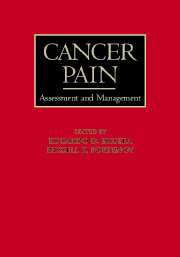Book contents
- Frontmatter
- Contents
- List of contributors
- Preface
- SECTION I MECHANISMS AND EPIDEMIOLOGY
- SECTION II ASSESSMENT AND SYNDROMES
- SECTION III PHARMACOLOGICAL TREATMENT
- SECTION IV NONPHARMACOLOGICAL APPROACHES
- 12 Anesthesiological procedures
- 13 Psychological interventions
- 14 Rehabilitation medicine interventions
- 15 Neurosurgical techniques in the management of cancer pain
- SECTION V THE ROLE OF ANTINEOPLASTIC THERAPIES IN PAIN CONTROL
- SECTION VI PAIN IN SPECIAL POPULATIONS
- SECTION VII DIFFICULT PAIN PROBLEMS
- SECTION VIII SPECIAL TOPICS
- Index
14 - Rehabilitation medicine interventions
from SECTION IV - NONPHARMACOLOGICAL APPROACHES
Published online by Cambridge University Press: 08 October 2009
- Frontmatter
- Contents
- List of contributors
- Preface
- SECTION I MECHANISMS AND EPIDEMIOLOGY
- SECTION II ASSESSMENT AND SYNDROMES
- SECTION III PHARMACOLOGICAL TREATMENT
- SECTION IV NONPHARMACOLOGICAL APPROACHES
- 12 Anesthesiological procedures
- 13 Psychological interventions
- 14 Rehabilitation medicine interventions
- 15 Neurosurgical techniques in the management of cancer pain
- SECTION V THE ROLE OF ANTINEOPLASTIC THERAPIES IN PAIN CONTROL
- SECTION VI PAIN IN SPECIAL POPULATIONS
- SECTION VII DIFFICULT PAIN PROBLEMS
- SECTION VIII SPECIAL TOPICS
- Index
Summary
Introduction
Rehabilitation is a term not frequently associated with the management of cancer pain. However, the rehabilitation concept is a framework in which cancer pain management resides. Rehabilitation may be defined as the process of restoration and maximization of quality of life through enhancing function and mitigating disability. A person's function is influenced by abilities and limitations, and includes domains of physical health, emotional status, intellect/cognition, vocational and avocational activity, social activity, and role fulfillment.
The burden of pain is manifested in an individual through suffering but also through impaired function and consequent reduction in independence, as well as alterations in social roles and self-image. Successful pain management, therefore, may bring about improved mobility and function, and thus quality of life. Pain management becomes an essential step in the successful rehabilitation of the cancer patient.
Rehabilitation interventions include both pain-managing and pain-relieving techniques, as well as efforts to improve function. Functionally oriented efforts may involve the application of strengthening, coordination, balance, and other training exercises; use of therapeutic equipment; and adaptive education. This chapter focuses on those interventions directed toward pain management. Some movement-based therapies are used for pain management, although their more frequently recognized benefits are strength, coordination, endurance, and balance. The pain management and functional improvement goals are never exclusive and frequently coexist for cancer patients throughout the course of the disease.
Rehabilitation philosophy
Rehabilitation has traditionally been viewed as an intervention used after a chronologically discrete onset of disability, such as may follow a cerebrovascular accident, traumatic spinal cord injury, or amputation. This model is widely accepted in both lay and medical professional populations, and the course of functional recovery is somewhat predictable (Fig. 14.1).
- Type
- Chapter
- Information
- Cancer PainAssessment and Management, pp. 238 - 260Publisher: Cambridge University PressPrint publication year: 2003

